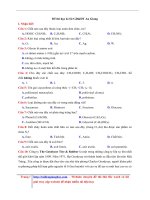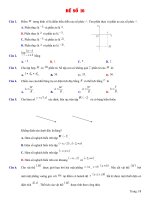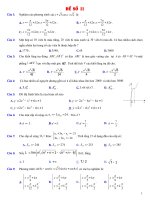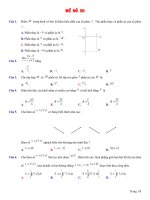- Trang chủ >>
- THPT Quốc Gia >>
- Ngoại Ngữ
De gv pham trong hieu hocmai file word co loi giai chi tiet
Bạn đang xem bản rút gọn của tài liệu. Xem và tải ngay bản đầy đủ của tài liệu tại đây (207.79 KB, 13 trang )
ĐỀ SỐ 01
MA TRẬN ĐỀ SỐ 01
Chuyên đề
Dạng bài
Đơn vị kiến thức
Nhận
biết
Ngữ âm
Q3,4
Q1,2
Phát âm
Trọng âm
Sai về ngữ pháp
Tìm lỗi sai
Cấp độ nhận thức
Vận dụng cao
Thông
Vận
hiểu
dụng
thấp
Dạng và thì động từ
Sự hòa hợp chủ vị
Từ loại
Giới từ/Cụm động từ
Mạo từ
Đại từ
Định từ và lượng từ
Lặp từ/ Thông tin thừa
Cấu trúc mệnh đề/câu
Q46
Q48
Q47
Sai về nghĩa
Thì động từ
Ngữ pháp
Hoàn thành
câu
Từ vựng
Câu giao tiếp
Từ đồng nghĩa
Từ trái nghĩa
Câu đồng
nghĩa
Nối câu
Điền từ
Đọc hiểu
Sự hòa hợp chủ vị
Mạo từ
Đại từ
Định từ và lượng từ
Liên từ
Giới từ/Cụm động từ
Cấu trúc mệnh đề/câu
Từ loại
Word choice
Collocation/ Idiom
Q11,12,13,14,
Q15,16
Q9
Q11,18,19,22
Q10,12,13
Q19
Q17,18,20,21
Q16
Q5,6
Q9,10
Q7,8
Q43,44,45
Q49,50
Q23,24,25,26,27
Q28,29,30,31,32,33
Q34,35,36,37,38,39
Q40,41,42
truy cập website – để xem lời giải chi tiết
PART 1.
Mark the letter A, B, C, or D on your answer sheet to indicate the word that differs from
the other three in the position of primary stress in each of the following questions.
Question 1:
Question 2:
PART 2.
A. offer
A. admire
B. attempt
B. happen
C. advise
C. complain
D. achieve
D. complete
Mark the letter A, B, C, or D on your answer sheet to indicate the word whose
underlined part differs from the other three in pronunciation in each of the following
questions.
Question 3:
Question 4:
PART 3.
A. scar
A. shame
B. pace
B. drank
C. shade
C. blaze
D. brave
D. cable
Mark the letter A, B, C, or D on your answer sheet to indicate the most suitable
response to complete each of the following exchanges.
Question 5: Thanks for all your help. "________________"
A. Don't mention it.
B. I don't think so
C. I’m sorry to hear that
D. It's nice of you
Question 6: I'm sorry. I've broken a glass. "_____________"
A. Why don't you try again?
B. That’s quite all right
C. I can't do that
D. I don't have it
PART 4.
Mark the letter A, B, C, or D on your answer sheet to indicate the word(s) OPPOSITE in
meaning to the underlined word(s) in each of the following questions.
Question 7: That is a rich family.
A. hard-up
B. wealthy
C. well-to-do
D. land-owning
C. fractious
D. disobedient
Question 8: These boys are mischievous.
A. well-behaved
B. naughty
PART 5.
Mark the letter A, B, C, or D on your answer sheet to indicate the word(s) CLOSEST in
meaning to the underlined word(s) in each of the following questions.
Question 9: They have a good relationship.
A. harmonious
B. failed
C. broken
D. fragile
C. healthy
D. strong
Question 10: They have a poor relationship.
A. friendly
B. difficult
truy cập website – để xem lời giải chi tiết
PART 6.
Mark the letter A, B, C, or D on your answer sheet to indicate the correct answer to each of
the following
Question 11: Now I _____________ Havard University.
A. am attending
B. attend
C. was attending
D. attended
Question 12: He has been selling motorcycles_________.
A. in ten years
B. for ten years
C. ten years ago
D. since ten years
Question 13: He fell down when he _________towards the church.
A. run
B. runs
C. was running
D. had run
Question 14: Columbus_________America more then 400 years ago.
A. he has gone
B. has discovered
C. had discovered
D. discovered
Question 15: We _________there when our father died.
A. still lived
B. lived still
C. was still living
D. were still living
Question 16: By Christmas, I_________for you for 6 months.
A. shall work
B. Shall have been working
C. have been working
D. shall be working
Question 17: ___________is a family unit that consists of a father, a mother, and their
children.
A. nuclear family
B. single-parent family C. extended family
D. big family
Question 18: We are a very _______family and support each other through any crisis.
A. old-established
B. close-knit
C. hard-up
D. well-to-do
Question 19: Her family and friends have given her lots of _________
A. supports
B. support
C. supporters
D. supportive
Question 20: She was brought up in a ________ family. She can’t understand the financial
problem we are facing.
A. kind
B. wealthy
C. broke
D. poor
Question 21: Mark enjoys having fun by causing trouble. He's a very _________boy.
A. stubborn
B. mischievous
C. spoiled
D. bright
Question 22: My family consist __________five people. my parents, my two younger
brothers and I.
A. of
B. over
C. up
D. bright
PART 7.
truy cập website – để xem lời giải chi tiết
Read the following passage and mark the letter A, B, C, or D on your answer sheet to
indicate the correct word or phrase that best fits each of the numbered blanks from 23
to 27.
Many people today would like the traditional two-parent family back, that is to say, they want
a man and a woman to (23)____________ for life; they also think the man should support the
family, and the woman should stay home with the children. However, few families now
(24)____________ in the this category. In fact, if more women decide to have children on
their own, the single-parent household may become more typical than the traditional family
in many countries. Also, couples may decide to have more children, or they might take in
foster children or (25)____________ . And because people are staying single and living
longer, there may be more one-person households.
(26)____________ the other hand, some people believe that similar events happen again and
again in history. if this is true, people may go back to the traditional (27)____________ or
nuclear family of the past. Others think that the only certainty in history is change. in other
words, the structure of the future family could begin to change faster and faster and in more
and more ways.
Question 23:
Question 24:
Question 25:
Question 26:
Question 27:
A. marry
A. belong
A. bring up
A. in
A.
B. wed
B. crowd
B. feel
B. at
B. extensive
C. engage
C. group
C. adapt
C. on
C. enlarged
D. gather
D. fall
D. adopt
D. for
D. big
PART 8.
Read the following passage and mark the letter A, B, C, or D on your answer sheet to
indicate the correct answer to each of the questions from 28 to 34.
FAMILY LIFE IN THE UNITED STATES
Family life in the United States is changing. Fifty or sixty years ago, the wife was called a
“housewife”. She cleaned, cooked, and cared for the children. The husband earned the money
for the family. He was usually out working all day. He came home tired in the evening, so he
did not do much housework. And he did not see the children very much, except on weekends.
These days, however, more and more women work outside the home. They cannot stay with
the children all day. They, too, come home tired in the evening. They do not want to spend the
evening cooking dinner and cleaning up. They do not have time to clean the house and do the
truy cập website – để xem lời giải chi tiết
laundry. So who is going to do the housework now? Who is going to take care of the
children?
Many families solve the problem of housework by sharing it. In these families, the husband
and wife agree to do different jobs around the house, or they take turns doing each job. For
example, the husband always cooks dinner and the wife always does the laundry. Or the wife
cooks dinner on some nights and the husband cooks dinner on other nights.
Then there is the question of the children. In the past, many families got help with child care
from grandparents. Now families usually do not live near their relatives. The grandparents are
often too far away to help in a regular way. More often, parents have to pay for child care
help. The help may be a babysitter or a day-care center. The problem with t his kind of help is
the high cost. It is possible only for couples with jobs that pay well.
Parents may get another kind of help form the companies they work for. Many companies
now let people with children work part-time. That way, parents can spend more time with
their children. Some husbands may even stop working for a while to stay with the children.
For these men there is a new word. they are called “househusbands”. In the USA more and
more men are becoming househusbands every year.
These changes in the home mean changes in the family. Fathers can learn to understand their
children better, and the children can get to know their fathers better. Husbands and wives may
also find changes in their marriage. They, too, may have a better understanding of each other.
Question 28: Sixty years ago, most women ____________
A. went out to work
B. had no children
C. did not do much housework
D. were housewives
Question 29: Nowadays, there are __________.
A. more women going out to work than before
B. more and more women staying with the children all day
C. more work outside the home than before
D. more housewives than before
Question 30: The word “laundry” in paragraph 2 is closest in meaning to______
A. tidying up
B. cooking and washing up
C. washing and ironing
D. Shopping
Question 31: It can be inferred from paragraph 4 that__________.
A. couples with low-paid jobs can’t afford the cost of a babysitter or a day-care center
B. grandparents can help care the children in a regular way
truy cập website – để xem lời giải chi tiết
C. all couples with jobs can pay for help from a babysitter or a day-care center
D. in the past, grandparents did not help the couples with child care
Question 32: The word “they” in paragraph 5 refers to _______________
A. husbands who stop working to stay with the children
B. fathers who spend more time with their children
C. parents who work part-time
D. children who spend more time with fathers than
Question 33: The changes in the American home mentioned in this passage may ______
A. help families
B. not happen
C. cause problems for a marriage
D. not change the children at all
Question 34: This article is about ________
A. American men as househusbands
B. housewives in America
C. how more American women are working
D. how family life in America is changing
Question 35: What does the companies in USA do to help parents?
A. Pay them more.
B. pay for hiring babysitter.
C. allow parents to work less than the usual.
D. help them to bring up their children.
PART 9.
Read the following passage and mark the letter A, B, C, or D on your answer sheet to
indicate the correct answer to each of the questions from 35 to 42.
The nuclear family, consisting of a mother, father, and their children, may be more an
American ideal than an American reality. Of course, the so-called traditional American family
was always more varied than we had been led to believe, reflecting the very different racial,
ethnic, class, and religious customs among different American groups.
The most recent government statistics reveal that only about one third of all current
American families fit the traditional mold and another third consists of married couples who
either have no children or have none still living at home. Of the final one third, about 20
percent of the total number of American households are single people, usually women over
sixty-five years of age. A small percentage, about 3 percent of the total, consists of unmarried
people who choose to live together; and the rest, about 7 percent are single, usually divorced
parents, with at least one child. Today, these varied family types are typical, and therefore,
normal. Apparently, many Americans are achieving supportive relationships in family forms
other than the traditional one.
Question 36: With what topic is the passage mainly concerned?
truy cập website – để xem lời giải chi tiết
A. The traditional American family
B. The nuclear family
C. The current American family
D. The ideal family
Question 37: The writer implies that _____.
A. there have always been a wide variety of family arrangement in the United States
B. racial, ethnic, and religious groups have preserved the traditional family structure
C. the ideal American family is the best structure
D. fewer married couples are having children
Question 38: The word 'current' in line 7 could best be replaced by which of the following?
A. typical
B. present
C. perfect
D. traditional
Question 39: In the passage, married couples whose children have grown or who have no
children represent _____.
A. 1/3 percent of households
B. 20 percent of households
C. 7 percent of households
D. 3 percent of households
Question 40: Who generally constitutes a one-person household?
A. A single man in his twenties
B. An elderly man
C. A single woman in her late sixties
D. A divorced woman
Question 41: What is nuclear family?
A. a social unit composed of two parents and one or more children.
B. a family consisting of a family nucleus and various relatives, as grandparents.
C. a family in which a parent brings up a child or children alone, without a partner
D. a hard-up family
Question 42: Unmarried people living together represent__________________.
A. 3 percent
B. 20 percent
C. 7 percent
D. 1/3 percent
PART 10.
Mark the letter A, B, C, or D on your answer sheet to indicate the sentence that is closest
in meaning to each of the following questions.
Question 43: I haven't met my grandparents for five years.
A. I often met my grandparents five years ago.
B. I last met my grandparents five years ago.
C. I have met my grandparents for five years.
D. I didn't meet my grandparents five years ago.
Question 44: We survived that accident because we were wearing our seat belts.
A. But for our seat belts, we would have survived that accident.
truy cập website – để xem lời giải chi tiết
B. Had we not been wearing our seat belts, we wouldn't have survived that accident.
C. Without our seat belts, we could have survived that accident.
D. If we weren't wearing our seat belts, we couldn't have survived that accident.
Question 45: "No, I won't go to work at the weekend," said Sally.
A. Sally refused to go to work at the weekend.
B. Sally promised to go to work at the weekend.
C. Sally apologized for not going to work at the weekend.
D. Sally regretted not going to work at the weekend.
PART 11.
Mark the letter A, B, C, or D on your answer sheet to indicate the underlined part that
needs correction in each of the following questions.
Question 46: My mother always get up early to prepare breakfast for everyone in the family.
A. get
B. to prepare
C. everyone
D. the family
Question 47: I prefer living in a nuclear family than a joint one.
A. living
B. nuclear
C. than
D. one
Question 48: He comes from a large family, all of them now live in Australia.
A. comes
B. large
C. them
D. live
PART 12.
Mark the letter A, B, C, or D on your answer sheet to indicate the sentence that best
combines each pair of sentences in the following questions.
Question 49: Some kinds of fish live in fresh water. Others live in sea water.
A. Some kinds of fish live in fresh water, for others live in sea water.
B. Some kinds of fish live in fresh water, and others live in sea water.
C. Some kinds of fish live in fresh water, or others live in sea water.
D. Some kinds of fish live in fresh water, so others live in sea water.
Question 50: My mother is very busy with her work at the office. She still takes good care of us.
A. In spite of being very busy with her work at the office, my mother takes good care of us.
B. Because my mother is very busy with her work at the office, she takes good care of us.
C. My mother is so busy with her work at the office that she cannot take good care of us.
D. My mother is too busy with her work at the office to take good care of us.
truy cập website – để xem lời giải chi tiết
LỜI GIẢI CHI TIẾT
Question 1: Đáp án A
Offer /ˈɔfər/
Attempt /əˈtɛmpt/
Advise /ædˈvaɪz/
Achieve /əˈʧiv/
Question 2: Đáp án B
Admire /ædˈmaɪr/
Happen /ˈhæpən/
Complain /kəmˈpleɪn/
Complete /kəmˈplit/
Question 3: Đáp án A
Scar /skar/
Pace /peɪs/
Shade /ʃeɪd/
Brave /breɪv/
Question 4: Đáp án B
Shame /ʃeɪm/
Drank /dræŋk/
Blaze /bleɪz/
Cable /ˈkeɪbəl/
Question 5: truy cập website – để xem lời giải chi tiết
Question 11: Đáp án A
“Now”: câu sử dụng thì hiện tại tiếp diễn
Question 12: Đáp án B
Câu sử dụng thì hiện tại hoàn thành và for + 1 khoảng thời gian
Question 13: Đáp án C
Câu là 1 hành động đang diễn ra 1 hành động khác xen vào => thì quá khứ tiếp diễn
Question 14: Đáp án D
Một hành động diễn ra trong quá khứ và kết thúc trong quá khứ => thì quá khứ
Question 15: Đáp án D
Một hành động đang diễn ra ở 1 thời điểm trong quá khứ => thì quá khứ tiếp diễn
Question 16: Đáp án B
“By Christmas”: câu sử dụng thì tương lai hoàn thành tiếp diễn
Question 17: truy cập website – để xem lời giải chi tiết
Question 26: Đáp án C
On the other hand: mặt khác
Question 27: Đáp án A
Extended family: gia đình gồm bố mẹ co cái và ông bà, cô dì,…
CUỘC SỐNG GIA ĐÌNH TẠI MỸ
truy cập website – để xem lời giải chi tiết
Cuộc sống gia đình ở Hoa Kỳ đang thay đổi. Năm mươi hay sáu mươi năm trước, người vợ
được gọi là “Bà nội trợ”. Cô làm sạch, nấu chín, và chăm sóc cho trẻ em. Người chồng kiếm
tiền
dành cho gia đình. Anh ấy thường làm việc cả ngày. Anh ta về nhà mệt mỏi vào buổi tối, nên
anh ta không làm nhiều việc nhà. Và anh ta không gặp mấy đứa trẻ nhiều lắm, ngoại trừ
những ngày cuối tuần. Ngày nay, ngày càng nhiều phụ nữ làm việc bên ngoài nhà. Họ không
thể ở lại với
những đứa trẻ cả ngày. Họ cũng về nhà mệt mỏi vào buổi tối. Họ không muốn dành cả buổi
tối để nấu ăn tối và dọn dẹp. Họ không có thời gian dọn dẹp nhà cửa và giặt giũ. Vậy ai sẽ
làm việc nhà bây giờ? Ai sẽ chăm sóc bọn trẻ?
Nhiều gia đình giải quyết vấn đề nhà cửa bằng cách chia sẻ nó. Trong những gia đình này,
người chồng và vợ đồng ý làm các công việc khác nhau quanh nhà, hoặc họ thay phiên nhau
làm mỗi công việc. Ví dụ, người chồng luôn nấu bữa tối và vợ luôn giặt quần áo. Hoặc vợ
nấu bữa tối vào một số đêm và người chồng nấu bữa tối vào những đêm khác.
truy cập website – để xem lời giải chi tiết
Question 28: Đáp n. án D
Fifty or sixty years ago, the wife was called a “housewife”.
60 năm trước, hầu hết phụ nữ….
A. ra ngoài làm việc.
B. không có con.
C.không làm quá nhiều việc nhà.
D. là những bà mẹ nội trợ.
Question 29: Đáp án A
These days, however, more and more women work outside the home.
Ngày nay, có….
A. ngày càng nhiều phụ nữ đi làm hơn trước.
B. ngày càng nhiều phụ nữ ở nhà trông trẻ hơn.
C. nhiều công việc bên ngoài hơn trước.
D. nhiều bà mẹ nội trợ hơn trước
Question 30: Đáp án C
Từ “laundry” gần nghĩa với từ nào:
Tidy up: dọn dẹp
Wash: rửa, giặt giũ quần áo
Iron: là, ủi đồ
Laundry: giặt quần áo
Question 31: Đáp án B
In the past, many families got help with child care from grandparents.
Điều được nhắc tới trong đoạn 4 là:
A. các cặp đôi không thể chi trả cho nguười trông trẻ và nhà giữ trẻ.
B. ông bà có thể chăm sóc lũ trẻ thưởng xuyên.
C. tất cả các cặp đôi có công việc hỗ trợ phí cho nhà trông trẻ và nhà giữ
trẻ.
D. trong quá khứ, ông bà không giúp việc trông trẻ
Question 32: Đáp án A
Some husbands may even stop working for a while to stay with the
children… they are called “househusbands”.
Từ “they” trong đoạn 5 nhắc tới:
A. người chồng nghỉ việc ở nhà với con.
truy cập website – để xem lời giải chi tiết
B. người bố dành nhiều thời gian với con.
C. bố mẹ làm việc bán thời gian.
D. những đứa trẻ dành nhiều thời gian cho bố của chúng
Question 33: Đáp án A
These changes in the home mean changes in the family. Fathers can learn
to understand their
children better, and the children can get to know their fathers better.
Sự thay đổi trong gia đình Mỹ có thể:
A. giúp đỡ gia đình.
B. chẳng xay ra chuyện gì.
C. gây ra những vấn đề trong hôn nhân.
D. k thay đổi bọn trẻ
Question 34: truy cập website – để xem lời giải chi tiết
Question 36: Đáp án C
The nuclear family, consisting of a mother, father, and their children, may
be more an American ideal than an American reality.
Đoạn văn chủ yếu nói về:
A. kiểu gia đình truyền thống Mỹ.
B. kiểu gia đình nhỏ.
C. kiểu gia đình Mỹ gần đây.
D. kiểu gia đình lý tưởng
Question 37: Đáp án A
Người viết đã chứng minh rằng.
A. có nhiều kiểu gia đình ở Mỹ.
B. chủng tộc, dân tộc, và tôn giáo đã bảo tồn cấu trúc gia đình truyền thống.
C. gia đình Mỹ lí tưởng là cấu trúc tốt nhất.
D. ngày càng ít cặp vợ chồng có con
Question 38: Đáp án B
Từ “current” có thể thay thế bằng từ nào:
Typical: điển hình
Present: hiện tại
Perfect: hoàn hảo
Traditional: truyền thống
Question 39: Đáp án A
only about one third of all current American families fit the traditional
mold and another third consists of married couples who either have no
children or have none still living at home.
Question 40: Đáp án C
Of the final one third, about 20 percent of the total number of American
households are single people, usually women over sixty-five years of age.
Những người sống 1 mình thường là:
A. đàn ông 20 tuổi.
B. ông già.
C. phụ nữ đơn thân trên 60.
D. phụ nữ đã li hôn
Question 41: Đáp án A
truy cập website – để xem lời giải chi tiết
The nuclear family, consisting of a mother, father, and their children
Question 42: Đáp án A
A small percentage, about 3 percent of the total, consists of unmarried
people
Question 43: Đáp án B
Câu có nghĩa: Tôi không gặp ông bà tôi đã 5 năm
Lần cuối tôi gặp ông bà là 5 năm trước
Question 44: Đáp án B
Câu có nghĩa: Chúng tôi sống sót khỏi tai nạn vì chúng tôi đang đeo dây an toàn
Nếu chúng tôi k đeo dây an toàn, chúng tôi không thể sống sót
Question 45: Đáp án A
Câu có nghĩa: Sally nói rằng:”Không, tôi sẽ không làm việc vào cuối tuần”
Sally từ chối làm việc vào cuối tuần
Question 46: Đáp án A
Get => gets
Question 47: Đáp án C
Prefer doing sth to doing sth: thích làm gì hơn làm gì
Question 48: Đáp án B
Large => extended
Question 49: Đáp án B
Câu có nghĩa: Có 1 vài loài cá sống ở vùng nước ngọt. Còn lại sống ở biển
Question 50: Đáp án A
Câu có nghĩa: Mẹ tôi rất bận với công việc. Cô ấy vẫn chăm sóc tốt cho chúng tôi
Mặc dù bận rộn với công việc nhưng mẹ vẫn chăm sóc tốt cho chúng tôi
truy cập website – để xem lời giải chi tiết
truy cập website – để xem lời giải chi tiết









